belt CHEVROLET MONTE CARLO 1976 2.G Owners Manual
[x] Cancel search | Manufacturer: CHEVROLET, Model Year: 1976, Model line: MONTE CARLO, Model: CHEVROLET MONTE CARLO 1976 2.GPages: 102, PDF Size: 23.79 MB
Page 3 of 102
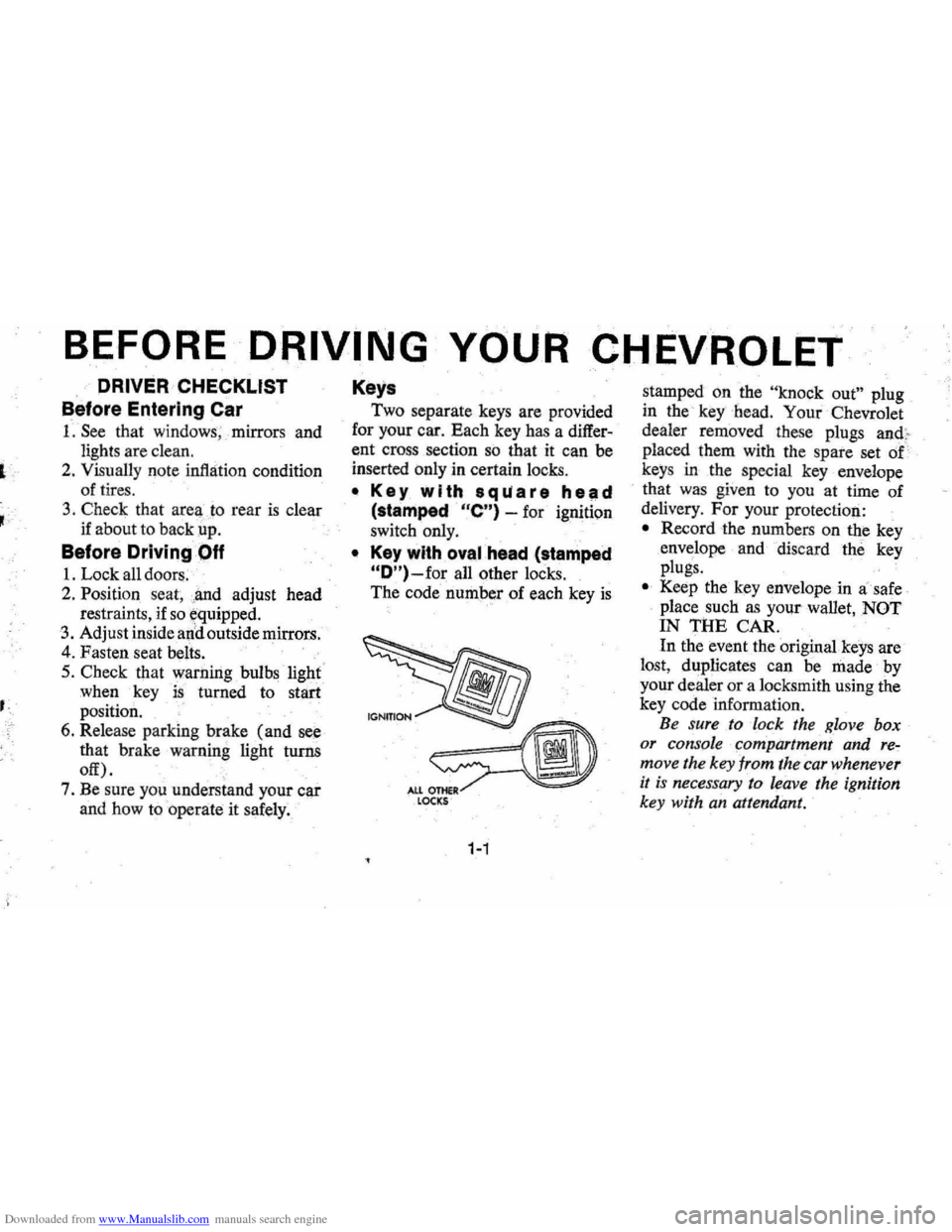
Downloaded from www.Manualslib.com manuals search engine ,
BEFORE DRIVING YOUR CHEVROLET
DRIVER CHECKLIST
Before Entering Car
1. See that windows ; mirrors and
lights are clean.
2. Visually note inJIation condition
of tires.
3. Check that area to rear is clear
if about to back up.
Before Driving Off
1. Lock all doors.
2. Position seat, jmd adjust head
restraints, if
so ¢quipped.
3. Adjus!insidean'd outside mirrors.
4. Fasten seat belts.
5. Check that warning bulbs light
when key
is turned to start
position. .
6. Release parking brake ( and see
that brake warning light turns
off). ,
7. Be sure you understand your car
and how
to 'operate it safely.
Keys
Two separate keys are provided
for your car. Each key has a
differ
ent cross section so that it can be
inserted only in certain locks.
• Key with s qua r e hell d
(stamped "e") -for ignition
switch only.
• Key with oval head (stamped
"O")-for all other locks.
,
The code number of each key is
All OTHeR LOCKS
1-1
stamped on the "knock out" plug
in the '
key-bead. Your Chevrolet
dealer removed these plugs
and,.
placed them with the spare set of
keys in the special key envelope
. that was given to you at time of
delivery.
For your protection:
• Record the numbers on the key
envdope and discard the key
plugs.
• Keep the key envelope in a safe
place such
as YOII! wallet, NOT
IN THE CAR.
In the event
the original keys are
lost,
dl!plicates can be made by
your dealer or a locksmith using the
key code information.
Be sure to lock the Klove box
or console
90mpartment and re~
move the key from the car whenever
it is necessary to leave the ignition
key with
an attendant.
Page 5 of 102
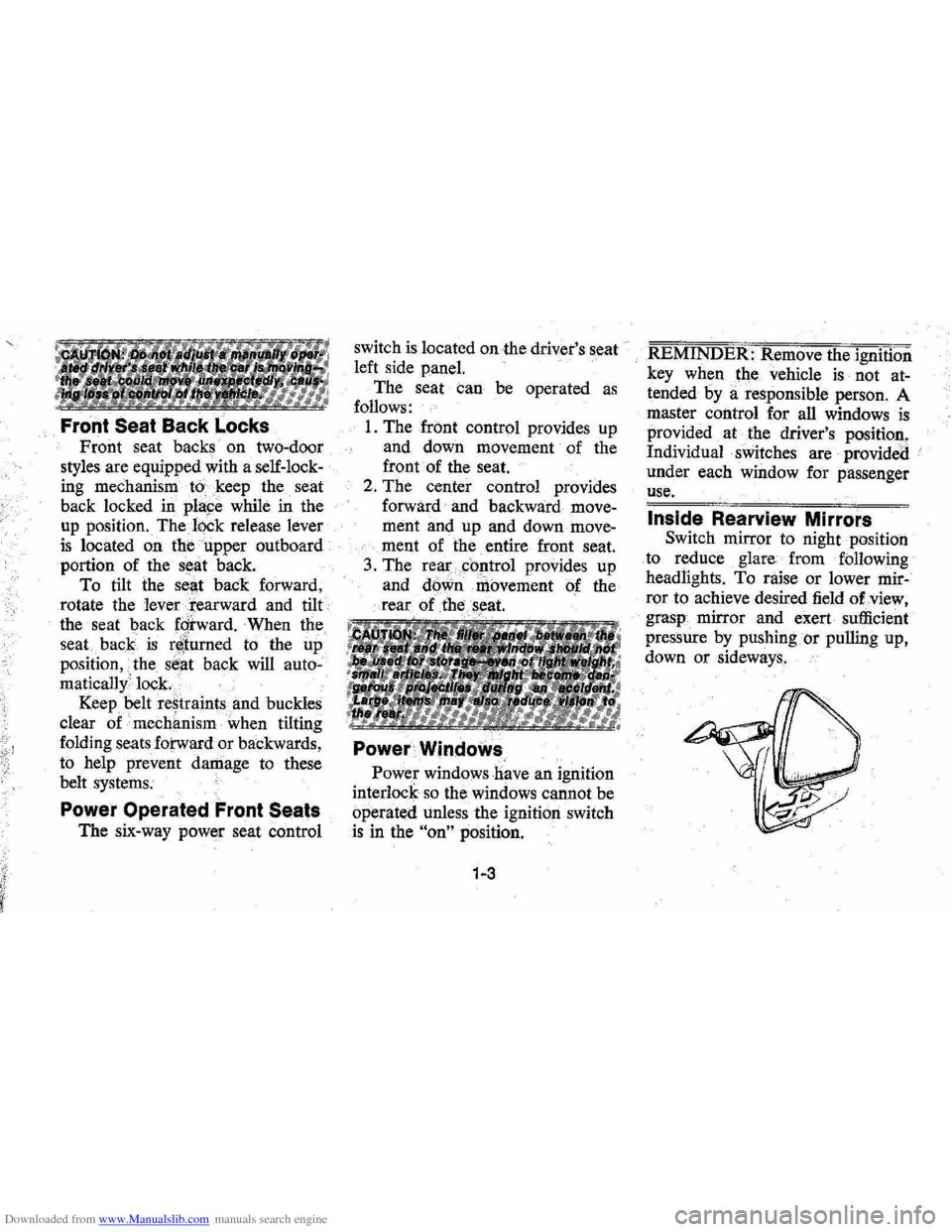
Downloaded from www.Manualslib.com manuals search engine Front Seat Back ... ~'""\ ..
Front seat backs on two-door
styles are equipped with a self-lock
ing mechanism to
.• keep the seat
back locked in
phlge while in the
up position. The lock release lever
is located on the upper outboard
portion of the
s~at back.
To tilt the
sell,t back forward,
rotate the levertearward and tilt
the seat back
f?rward. When the
seat back
is r¢turned to the up
position,
• the se~t back will auto
matically 'lock.
Keep
belt re~traints.and buckles
clear of mechanism when tilting
folding seats
forward or backwards,
to help prevent damage
to these
belt systems.
Power Operated Front Seats
The six-way power seat control switch
is located
on the driver's seat
left side panel.
The seat can be operated
as
follows:
I. The front control provides up
and down movement of the
frontof the seat.
2. The center control provides
forward and backward move
ment and up and down move
ment of the entire front seat.
3. The provides up
and of the
Power Windows ,
Power windows have an ignition
interlock
so the windows cannot be
operated unless the ignition switch
is in the "on" position.
1-3
REMINDER: Remove the ignition
key when the vehicle
is not at
tended by a responsible person. A
master control for all windows
is
provided at the driver's position,
Individual switches are provided
under each window for passenger
use.
Inside Rearview Mirrors
Switch mirror to night position
to reduce glare from following
headlights. To raise or lower
mir
ror to achieve desired field of.view,
grasp mirror and exert sufficient
pressure by pushing or pulling up,
down or sideways.
Page 6 of 102
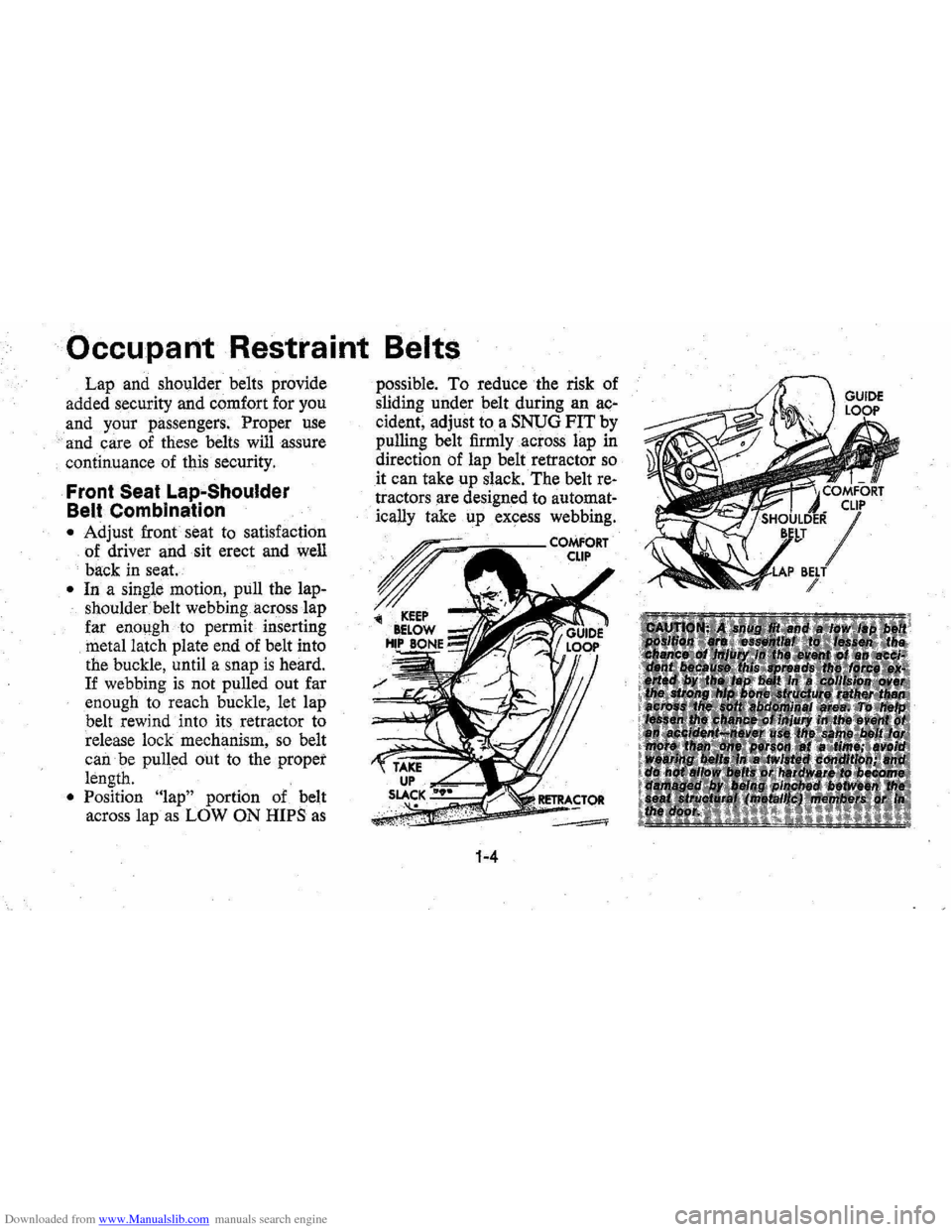
Downloaded from www.Manualslib.com manuals search engine Occupant Restraint Belts
Lap and sholjlder belts provide
added security and cgmfort for you
and your passengers. Proper
use
and care of these belts will assure
continuance of this security.
Front
Seat Lap-Shoulder
Belt Combination
• Adjust front seat to satisfaction
of driver and sit erect and well
back in seat.
• In a single motion, pull the lap
shoulder belt webbing across lap
far enough to permit inserting
. metal latch plate end of belt into
the buckle, until a snap
is heard.
If webbing is not pulled out far
enough
to reach buckle, let lap
belt rewind into its retractor to
release lock mechanism,
so belt
can be pulled out
to the proper
length.
• Position "lap" portion of belt
across lap
as LOW ON HIPS as
possible. To reduce the risk of
sliding under belt during an
ac
cident, adjust to a SNUG FIT by
pulling belt firmly across lap in
direction of lap belt retractor
so
it can take up slack. The belt re
tractors are designed to automat
ically take up excess webbing.
1-4
Page 7 of 102

Downloaded from www.Manualslib.com manuals search engine • The front seat shoulder belts in
this vehicle are equipped with
a
"vehicle sensitive retractor"
which
is de!\,igned to grip the belt
-only during a sudden stop or im
pact. At other times it is de
signed to move freely with the
occupant. .:
• For best restrainUhe slight ten
sion on the shoulder caused by
the shoulder belt retractor
is de
sirable.
• A comfort clipis provided for
those who
find the shoulder belt
tension a
source of discomfort. If
the shoulder belt tension becomes
uncomfortable ;. pull down on the
shoulder belt
to provide the least
amount of
slaek necessary to re
lieve tension (hot more than one
inch). Then
push the comfort
clip snugly against the guide
loop.
To unfasten button
in center
of buckle.
• When no longer in use, front seat
lap-shoulder belts can be stowed
by allowing
them to rewind into
their retractors. The comfort clip
can be adjusted when removing
belts,
so shoulder belt slack will
be fully taken up by retractor.
NOTE: Take care not to let the
pOlrtio,rl-of the belt twist while
1-5
it is being rewound into the retrac
tor. The bulk of the twisted belt
m .ay cause
t~e retractor to jam so it
WIll not reWind further, while at the
same time the retractor locking
mechanism may. prevent the belt
from being withdrawn. To release
a jammed belt, open the cover on
the rear of the retractor and rotate
the key slot while pulling the belt
upward. This should allow the belt
to be untwisted.
lfyour retractor
does not have such a key slot or for
some reason the lap belt portion
re
mains ' jammed, orother parts of
the restraint system do not operate
properly take the
ve!).ic1e to your
dealer
for service .
Page 8 of 102

Downloaded from www.Manualslib.com manuals search engine Beit Restraint Bu~zer/Light
Reminder
• When .the ignition key is turp.ed
to On or Start, a ,reminder light
is desigl1ed to come on for four
to eight seconds,
to remind occu
pants to fasten their belt re'
straints.
• If the driver hils not buckled
his belt restraint prior to turning
th~key to On or Start, a buzzer
is . ,designed to sound for four to
, dei~t seco'Yds to remind h.i!I!' to
9 so. ".
If ,the belt restraint system or
reminder system
dOes not work as
described,
see your Chevrolet
dealer for information and
assis
tance.
Lap Belts (For Rear Seat and
Center ·,Fr,on1 Seal
Passengers)
• Seating positions next to side
windows (except station wagon third
seats)
' have retractors
'which ar!) designed to automat
ically take.up¢xcess webbing.
, TIrese beltS should be positioned,
secured
ahd released as described
above undei
"Lap-Shoulder Belt
Combination." (Retractors are
, available as an option on station
wa.gon third seats. ) ,
•
Lap belts at center seating posi
tions
( and third seats) also
should be positioned, secured
and
releaseda.s described above, '
arjd adjusted'fo a SNUG FIT by
pulling on the end of the belt ex
teiiaing froin the adjustable latch
plai~. '
• To .;lengthen.Jap
belt at center
seating
positions (and station
wagonthitd seats) place adjust
able ,latch 'plate
at right angles to
the belt webbing and pull on
latch plate; belt
should then slide
easily thro)lgh the adjus\ment
featute.
r'~
Optional Sho~lder ~elts
(Rear Seat, Outboard)
• Whenptoperlil>vorn with a lap
belt,a shoulde~;belt can provide
l\dditiona.! protej;tion by prevent
ing or minimizing impact with
the car interior;
by restraining
forward rnotion of the upper
torso in a ,collision. This
is par~ ,
ticularlytrue in 'the case of a
frontalforce impact.
Page 9 of 102

Downloaded from www.Manualslib.com manuals search engine o To fasten the· detachable shoul
der belt,
unstow it and place the
knob on the shoulder belt end
into the keyhole on the lap belt
latch plate.
(The latch is de
signed
so that this attachment
can only be completed before
fastening the lap belt.) Tilt the
knob as necessary , to pass it
through the slot.
Pull the knob
firmly upward to seat it at the
narrow end of the keyhole, then fasten
the lap belt. Reverse this
procedure when removing and
restowing the shoulder belt.
o The detachable shoulder belts
are lengthened and shortened in
the same manner as center seat
lap belts.
o The detachable shoulder belt
should have sufficient slack to
in
sert a fist's width between your
chest and the belt. This can be
checked
by inserting a clenched
fist between · the belt and your
chest with thumb against chest
and
back of hand facing upward.
Belt Restraint Inspection
o Periodically inspect belts,
buckles, adjustable latch plates,
1-7
retractors, reminder systems,
guide loops, clips,
and anchors
for damage that could lessen the
effectiveness
of the retraint
system.
o Keep sharp edges and damaging
objects away from belts, and
other parts of restraint system.
o Replace belts if cut, weakened,
frayed,
or subjected to collision
loads.
o Check that anchor mounting
bolts are tight.
o Have questionable parts re
placed.
o Keep belts clean and dry.
o Clean only with mild soap solu
tion and lukewarm water.
o Do not bleach or dye belts since
. this may severely weaken belts.
Head Restraints
o Head restraints are designed to
help reduce injuries due to
"whiplash".
Page 11 of 102

Downloaded from www.Manualslib.com manuals search engine net should be securely restrained
with the regular vehicle belt re
straints.
An alternate method is
to position the bassinet so that it
. rests against the back of the front
seat, again crossways in the
vehicle.
2. Children able
to ,sit up by them
selves should be. placed
on a seat
and restrained with a belt
re'
straint. When children ride in the
front seat, both lap and
shoulder belt should be worn.
If
the shoulder belt causes neck or
face irritati on due to the child's
size, this may be reduced in some
cases by positioning the child
further inboard.
If serious dis
c.omfort continues, the . child
sh.ould be lap belted in the rear
seat. Never allow a child to stand
.or kneel on any seat .
•
3. General ' M.otors recommends
that childr~n be restrained pr.op
erly when riding. However, if
unusual
c.onditi.ons pr.ohibit use
.of restraints and require' that a
child must stand, he
sh.ould stand
.on the floor directly behind the
front seat. This will help mini
mize the possibility
.of injury
from frontal
f.orce impacts in the
event .of an accident.
,
•
Page 13 of 102
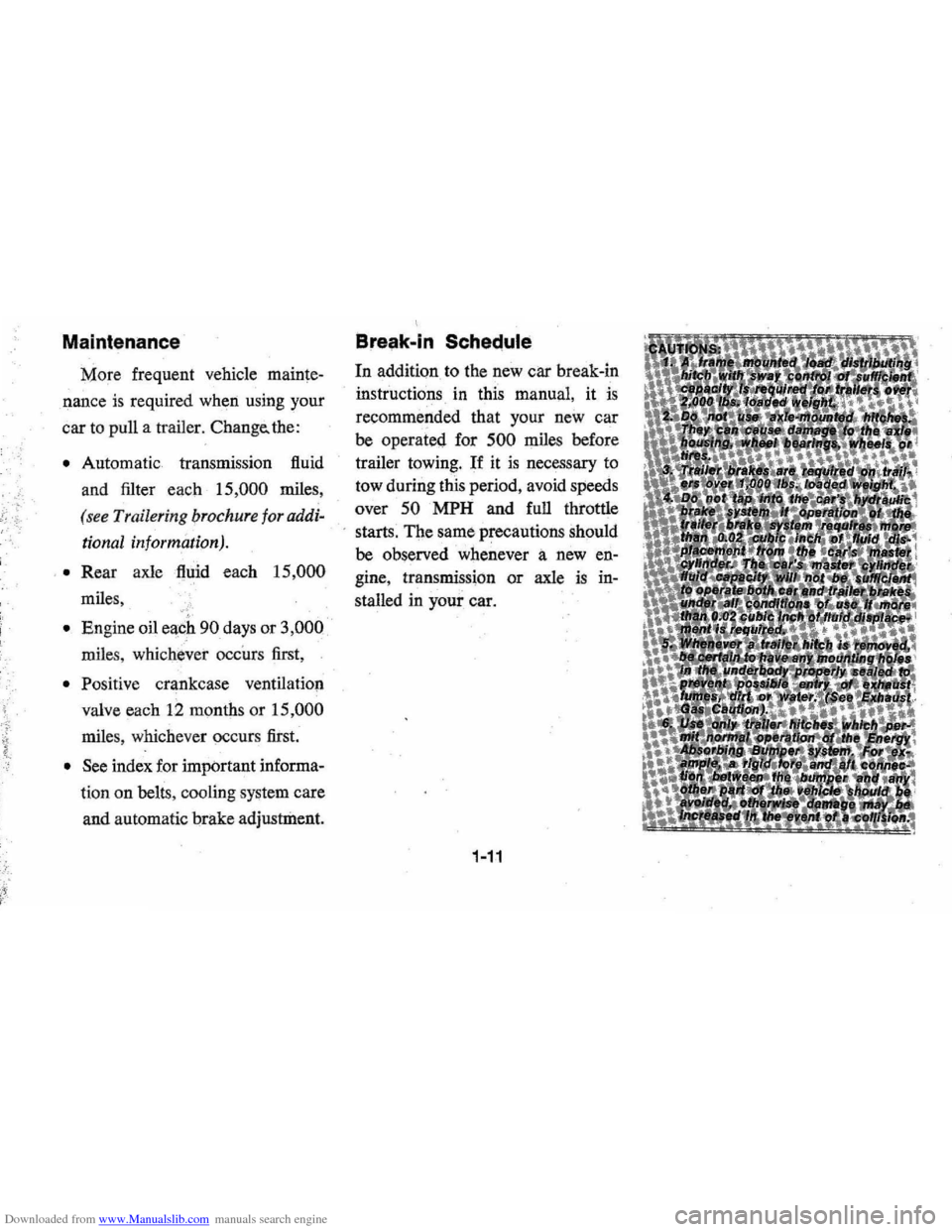
Downloaded from www.Manualslib.com manuals search engine . . "
Maintenance
More frequent vehicle mainte
nance
is required when using your
car
to pull a trailer. Change. the:
• Automatic transmission fluid
and filter each 15,000 miles,
(see Trai/ering brochure foraddi
tional information).
.• Rear axle fluid each 15,000
miles,
• Engine oil each 90 days or 3,000
miles , whichever occurs first,
• Positive crankcase ventilation
valve each
12 months or 15,000
miles, whichever occurs first.
• See index for important informa
tion on belts, cooling system care
and automatic brake
adjuslrilent.
Break·in Schec;!ule
In addition to the new car break-in
instructions in this manual, it
is
recommended that your new car
be operated for 500 miles before
trailer towing.
If it is necessary to
tow during this period, avoid speeds
over
50 MPH and full throttle
starts. The same precautions should
be observed whenever a new
en
gine , transmission or axle is in
stalled in your car.
1·11
Page 46 of 102
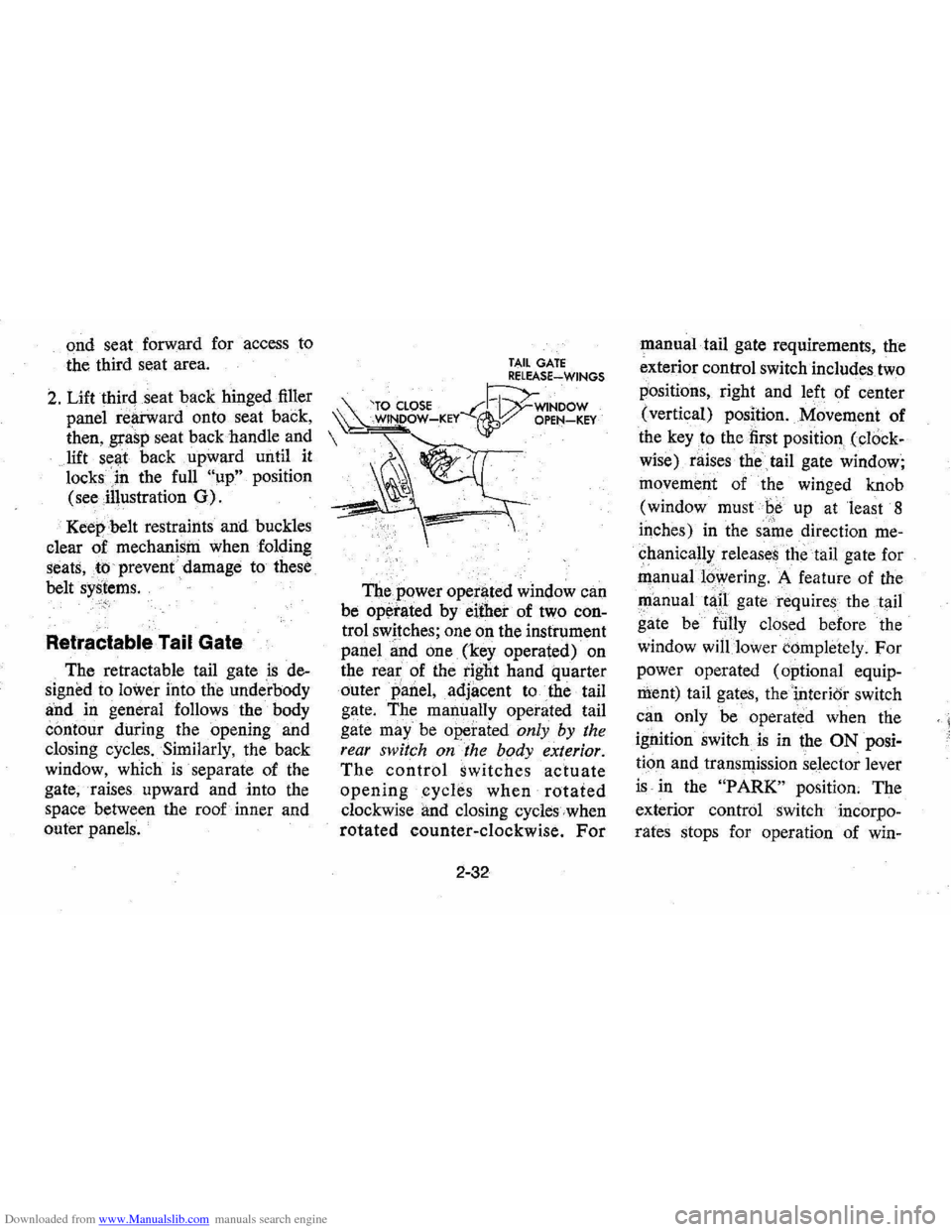
Downloaded from www.Manualslib.com manuals search engine ond seat forward for access to
the third seat area.
2. Lift third seat back hinged filler
panel
rearward onto seat back,
then, grasp seat back handle and
lift seat
back. upward until it
locks
in the full "up" position
(see illustration
0).
Keep belt restraints and buckles
clear of mechanism when folding
seats,to prevent damage to these
belt
systems. C·>·i
Retractable Tail Gate
The retractable tail gate is de
signed to
lower into the underbody
and in general follows the body
contour during the opening and
closing cycles. Similarly, the back
window, which
is separate of the
gate, raises upward and into the
space between the roof inner and
outer panels.
TAIL GATE RELEASE~WINGS
'TO CLOSE --C~WINDOW ~ WINDOW-KEY ~:/ OPEN-KEY
The power operl)ted window can
be
op~rated by either of two con
trol switches; one on the instrument
panel
~nd one (key operated) on
the
rea~ of the tight hand quarter
outer
panel, adjacent to the tail
gate. The manually operated tail
gate
may" be operated only by the
rear switch on the body exterior.
The control switches actuate
openingcycle.s when rotated
clockwise and closing cycles when
rotated counter-clockwise. For
2-32
manual tail gate requirements, the
exterior control switch includes two
positions, right and left of center
(vertical) position. Movement of
the
key to the first position (cl()ck
wise) raises the
tail gate window;
movement of the winged knob
(window must
Be up at least 8
iqches) in the same direction me
chanical!>: releases the tail gate for
manual16wering. A feature of the
~anual tap gate requires the tail
gate be
fUlly closed before the
window
will lower completely. For
power operated (optional equip
ment) tail gates, thei,nterior switch
can only be operated when the
ignition switch
is in the ON posi
tion and transll)ission selector lever
is in the "PARK" position. The
exterior control switch incorpo
rates stops for operation of win-
< I
Page 57 of 102
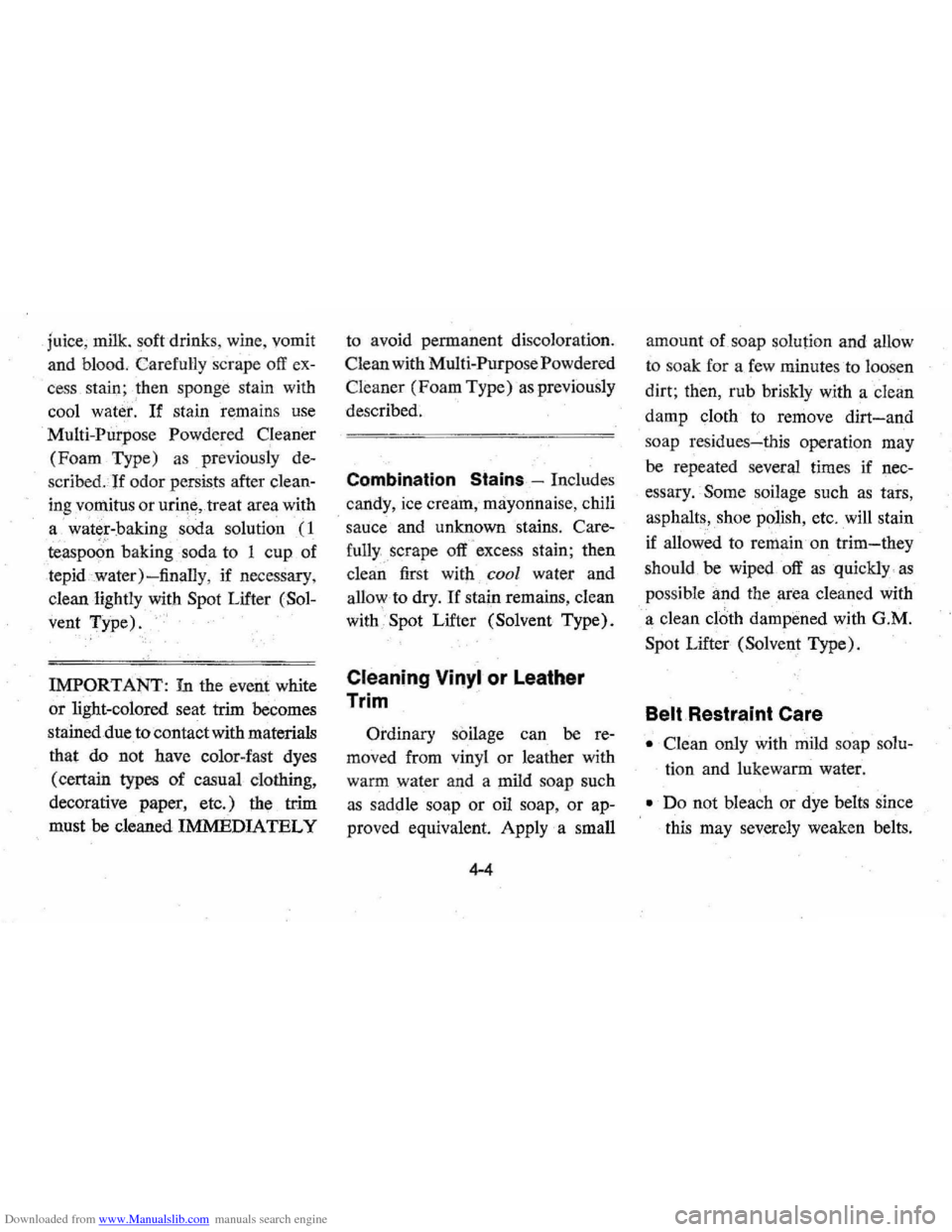
Downloaded from www.Manualslib.com manuals search engine juice, milk . soft drinks , wine , vomit
and blood . Carefull y scrape o
ff ex
cess stain; ,then sponge stain with
cool
water. If stain remains use
Multi-Purpose Powdered Cleaner
(Foam Type) as previously de
scribed.If odor persists after clean
ing vomitus or urine, treat area with
a water-baking soda solution (1
teaspoon baking soda to 1 cup of
tepid
water ) -finally, if necessary ,
clean lightly with
Spot Lifter (Sol
vent Type).
IMPORTANT: In the event white
or light-colored seat trim becomes
stained due
to contact with materials
that
do not have color-fast dyes
(certain types
of casual clothing ,
decorative paper, etc. )
the trim
must be cleaned
IMMEDIATELY
to avoid permanent discoloration.
Clean with Multi-Purpose Powdered
Cl eaner
(Foam Type) as previously
described.
Combination Stains -Includes
, candy, ice cream, mayonnaise, chili
sauce and unknown stains.
Care
fully.scrape off'excess stain; then
clean first with cool water and
allow to dry,
If stain remains , clean
with , Spot Lifter (Solvent Type).
Cleaning Vinyl or Leather
Trim
'
Ordinary s oilage can be re
moved from vinyl or leather with
warm water and a mild soap such
as saddle soap
or oil soap , or ap
proved equivalent. Apply a small am
ount
of soap solution and allow
to so
ak for a few minutes to loosen
dirt; then,
rub briskly with a clean
damp cloth to remove dirt-and
so ap residues-this operation may
be repeated several times if nec
essary. Some soilage such as tars,
asphalts, shoe polish, etc, will stain
if allowed to
remain on trim-they
should be wiped off as quickly , as
possible and the area cleaned with
a clean
cloth dampened with G.M.
Spot Lifter (Solvent Type).
Belt Restraint Care
• Clean only with mild soap solu
tion and lukewarm water.
• ,Do not bleach or dye belts since
this
may severely weaken belts.